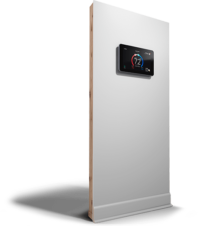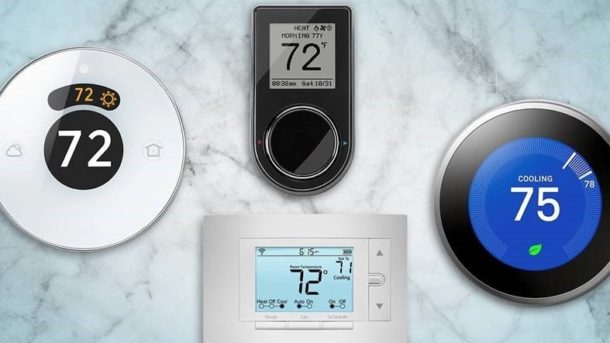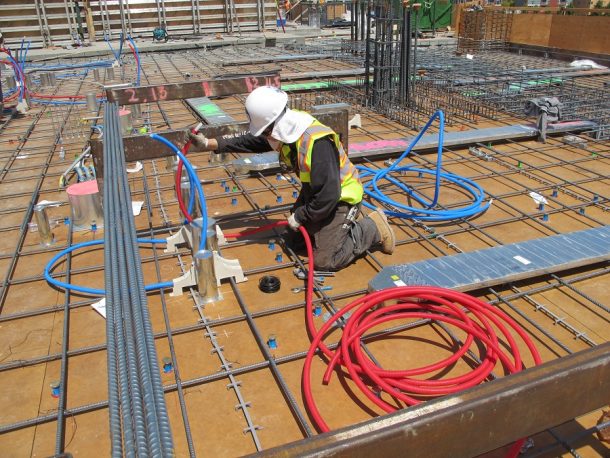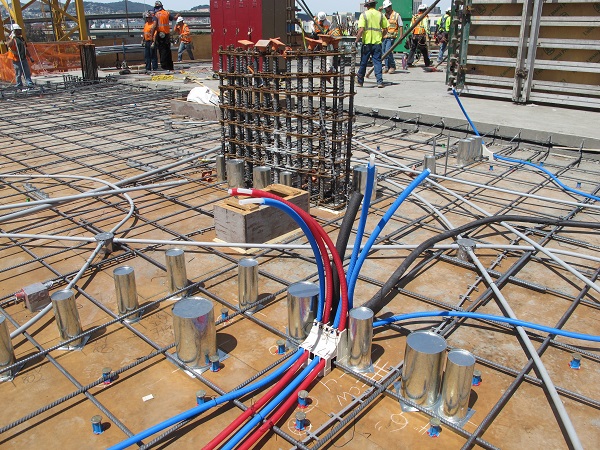Homes are getting smarter as technology evolves, and devices like smart thermostats enable homeowners to create a perfect oasis inside their home while also lowering utility bills. As an HVAC expert, homeowners will look to you for guidance on choosing the right thermostat, so understanding the different variations and features of smart home technology is Read more
Guest Blog

 Homes are getting smarter as technology evolves, and devices like smart thermostats enable homeowners to create a perfect oasis inside their home while also lowering utility bills. As an HVAC expert, homeowners will look to you for guidance on choosing the right thermostat, so understanding the different variations and features of smart home technology is key.
Homes are getting smarter as technology evolves, and devices like smart thermostats enable homeowners to create a perfect oasis inside their home while also lowering utility bills. As an HVAC expert, homeowners will look to you for guidance on choosing the right thermostat, so understanding the different variations and features of smart home technology is key.
To determine which thermostat will achieve a homeowner’s own personal degree of perfection, ask your customer these questions:
- How do you want to feel in your home?
A homeowner may not know what device or equipment they want, but they do know how they want to feel in their home. Asking them to describe their ideal environment and how they prefer the air around them to feel will help you get a sense for their individual level of comfort.  What do you hope to gain from having a smart thermostat?
What do you hope to gain from having a smart thermostat?
Is your homeowner looking for an easy way to control the temperature? Do they want to lower their energy bills or even-out the humidity levels in their home? Curate your smart thermostat recommendations around the homeowner’s greatest needs, which oftentimes are not mutually exclusive. Lennox’ iComfort S30 Ultra Smart Thermostat includes Allergen Defender, a feature that monitors and cleans the air in the home, and the ability to control temperature remotely from a smartphone.- What level of control do you want over the temperature and air quality in your home?
Some homeowners want to monitor their home temperature remotely any time of day, while others prefer to set the perfect temperature once and leave it alone. If your homeowner opts for the former, choose a smart thermostat that provides a granular level of control and extensive remote capabilities. For example, the iComfort S30’s Smart Away Mode uses GPS to detect how far away the homeowner is from the house and adjusts the temperature accordingly. On the other hand, Lennox’ iComfort E30 Smart Thermostat’s Perfect Temp feature allows the homeowner to set the desired temperature and the system will automatically adjust heating and cooling to maintain that setting. Identifying the homeowner’s perfect level of comfort is key to suggesting the optimal smart thermostat. - Do you want a thermostat that is compatible with digital assistants?
Some homeowners prefer to control temperature and air quality through a digital assistant. Lennox’ iComfort smart thermostats are compatible with assistants like Google Assistant, Apple HomeKit and Amazon Alexa to create the ultimate comfort experience.
 Smart thermostats not only provide a wealth of benefits to homeowners, including decreased energy usage and control over temperature levels, but they can also improve how you work and interact with customers.
Smart thermostats not only provide a wealth of benefits to homeowners, including decreased energy usage and control over temperature levels, but they can also improve how you work and interact with customers.
- Proactive troubleshooting. Oftentimes, smart thermostats will alert you when there is an issue with your customer’s HVAC systems. This allows you to proactively fix the problem, even before the homeowner is aware there is an issue. Through Lennox’ Dealer Portal, dealers can – when permitted by the homeowner – diagnose problems with the HVAC system and fix them remotely.
- Improved relationships with homeowners. Installation assistance and remote access provided by smart thermostats enable dealers to maintain and nurture relationships with the homeowner. Relationships are no longer one and done – you can be an ongoing resource for a homeowner with the touch of a button.
- Increased ease of installation. Smart thermostats don’t have to be difficult and time-intensive to install. For example, Lennox makes it easy through a four-wire installation with the S30 and E30. With faster and simpler installation, you can shift your focus to forming and nurturing long-lasting relationships with your customer.
Having a variety of options and capabilities allow both dealers and homeowners to find the ideal thermostat to meet their respective needs. Homeowners can surround themselves with perfect air, while dealers can provide higher levels of customer service. To learn more about how to help your homeowner find their perfect level of comfort, visit the Lennox website.
 Guest Blogger: Sweta Hari is the Director of Product Management for Controls and Indoor Air Quality at Lennox International. She and her award-winning team are responsible for ideating, developing and commercializing products that improve home efficiency and honor Lennox’ commitment to healthy and comfortable air. With an intense focus on the HVAC dealer and homeowner’s customer experience in mind, Sweta and her team deliver industry-leading products that are recognized for their thoughtful design and overall functionality.
Guest Blogger: Sweta Hari is the Director of Product Management for Controls and Indoor Air Quality at Lennox International. She and her award-winning team are responsible for ideating, developing and commercializing products that improve home efficiency and honor Lennox’ commitment to healthy and comfortable air. With an intense focus on the HVAC dealer and homeowner’s customer experience in mind, Sweta and her team deliver industry-leading products that are recognized for their thoughtful design and overall functionality.

With the increase in smart technologies and IoT, modernity seems to be an era of limitless innovation. While many commercial utility operators are searching for reliable and secure ways to optimize technology in their properties, they often wonder how to fully trust new smart communication solutions. Since certain applications are tailored to either wired or Read more
With the increase in smart technologies and IoT, modernity seems to be an era of limitless innovation.
While many commercial utility operators are searching for reliable and secure ways to optimize technology in their properties, they often wonder how to fully trust new smart communication solutions.
Since certain applications are tailored to either wired or wireless technologies, it comes down to choosing the right one. Let’s take a deeper look at both wired and wireless applications for smart IoT technology in commercial properties.

1. Reliability
Wired: Cables are used. Network devices are connected at all times and do not interfere with other connected devices.
Wireless: No cables are used. Networks connect within a certain range and are visible to other networks and connected devices, which can compromise the reliability of any connection.
2. Speed
Wired: Transfer speeds do not rely on location or capability of configuration in relation to a network. Speed of data transmission heightens with a wired connection. Less mobility provided.
Wireless: Transfer speeds vary and rely on location as well as capability of configuration. The farther you are from a wireless device, the slower the speed may be. In this case, sometimes a hybrid solution is presented that brings both wired and wireless technologies into a building.
We all know wireless routers can lose connection and go offline, but it doesn’t mean this connection is integral to operations. A wireless connection will not necessarily change the operation of equipment but can interfere with data transfers.
3. Security
Wired: Real-time flow of information is transmitted through wires and cannot be easily intercepted. Well protected from unauthorized access.
Wireless: A real-time flow of information is transferred via radio wave. Can easily be intercepted if encryption technologies are not used, but when properly secured, wireless networks are relatively safe.
Let’s say a 30 minute period of downtime took place in your building and routers needed to be rebooted. If any major event were to happen during this 30 minute period of downtime, data transfers may get lost and wireless applications related to safety or security would be inadequate.

4. Set up and Interference
Wired: Can be difficult and expensive to set up. One wired network will not affect the other. With LAN (ethernet) or WAN connection, wifi is not needed.
Wireless: Can be difficult and expensive to set up. More equipment may be needed to provide connectivity (wireless routers, access points, adapters). Wifi, WLAN, WPAN (bluetooth) or cellular data is needed for connection.
To summarize — if you fit the profile of a property manager looking to implement smart IoT management technology into your building, choosing between wired and wireless applications can clearly be difficult.
It’s often assumed wireless technology is a more innovative and tech-savvy option than wired technology — but it really does come down to the type of applications used in your property and if you can afford the risk of downtime.
If you are concerned about cost or maximum security and aren’t necessarily looking for mobility, a wired connection can serve your needs. On the other hand, if you are not concerned about cost and prefer mobility in your applications, then a wireless connection is the way to go.
Major events happen way too often in commercial buildings, so it’s important to be preemptive and protect your assets, wired or not. How will you optimize technology in your property in the era of innovation?
Visit our website for more information www.reedwater.io
 Adam Bartman, is a second generation plumber from Toronto, Canada. He began his career working alongside his father every summer from age 14-18. After highschool, he enrolled in the HVAC technician program at George Brown College and near the end of the course, his father opened a new plumbing company utilizing his 30+ years in the commercial market. Adam worked for the plumbing company and in 13 years went from one truck to 15, along with completing and obtaining his Journeyman Plumbing Licence & red-seal designation.
Adam Bartman, is a second generation plumber from Toronto, Canada. He began his career working alongside his father every summer from age 14-18. After highschool, he enrolled in the HVAC technician program at George Brown College and near the end of the course, his father opened a new plumbing company utilizing his 30+ years in the commercial market. Adam worked for the plumbing company and in 13 years went from one truck to 15, along with completing and obtaining his Journeyman Plumbing Licence & red-seal designation.
Two years ago, faced with many clients experiencing water related issues such as leaks and floods, high water use and inability to control water shut-offs throughout commercial buildings, Adam teamed up with an old friend, Avi Yurman, to develop and create a software/hardware based technology to mitigate the damages suffered in about 300+ commercial properties they served. They spent about 1-year in development and another year selling their new commercialized product, and have seen continued growth in 2019.

With plumbing hygiene becoming a bigger concern in our industry, installers and building owners are looking to innovations that will ensure both efficiencies and reduced liability for their domestic water systems. For these commercial plumbing applications, professionals are starting to turn to pre-sleeved PEX in the slab. It’s an innovative solution that offers several benefits Read more
With plumbing hygiene becoming a bigger concern in our industry, installers and building
owners are looking to innovations that will ensure both efficiencies and reduced liability for their domestic water systems.

San Francisco, 2018 install with in-slab, pre-sleeved PEX
For these commercial plumbing applications, professionals are starting to turn to pre-sleeved PEX in the slab. It’s an innovative solution that offers several benefits for the contractor, owner and also the end user, including:
- Shorter pipe runs for less material usage and better pressure to the fixtures
- No hangers for less ladder time and faster installs
- No insulation required for easier, more efficient installs
- Long, flexible coils of pipe to eliminate fittings in the slab
And here’s where the safety factor comes in — because in-slab pre-sleeved PEX systems use shorter runs of pipe embedded in concrete, the water in the pipe is spending less time in the optimal bacterial grow zone (95°F to 115°F). Plus, the shorter pipe runs provide better pressure to the fixtures for higher velocity to minimize biofilm attachment and growth, especially compared to metallic piping systems.

San Francisco, 2018 install with in-slab, pre-sleeved PEX
In general, PEX is a superior product compared to metallic piping due to its corrosion resistance, freeze resistance, superior sound insulation qualities, smoother surface for reduced pressure loss and lighter weight for easy maneuverability on the job site.
Also, because PEX has stable pricing compared to copper, it’s easier to confidently bid a job without having to worry about price increases. And because PEX connections don’t require flame, there’s no need for fire watch requirements on a job site, adding to the cost-effective benefits of the system.
So you can see how adding pre-sleeved PEX in the slab can offer great benefits to your commercial plumbing systems. Now, the next question is, what can you buy and where do you get it?
Some PEX manufacturers offer their pre-sleeved piping with color-coded red and blue HDPE corrugated sleeving to easily identify hot and cold water lines. The HDPE sleeve protects the pipe in the slab and also makes it easier to remove, if necessary, without having to break up the slab. Pipe sizes are typically available from ½" to 1", but can vary by manufacturer.
To learn more about the pre-sleeved PEX offerings in your market, check out your favorite PEX manufacturer’s website; or to learn more about PEX in general, visit one of the plastic piping association websites at plasticpipe.org or ppfahome.org.
 Guest Blogger: Kim Bliss is the content development manager at Uponor. She can be reached at kim.bliss@uponor.com.
Guest Blogger: Kim Bliss is the content development manager at Uponor. She can be reached at kim.bliss@uponor.com.

Following the footsteps of Frederick Law Olmstead, I try, every day, to immerse myself into green spaces. Considered the “father” of American landscape architecture, and known for his critical thinking in urban planning and design, Olmstead—of Central Park fame—encouraged the full utilization of the naturally occurring features of a given natural space. To Olmstead, a Read more
Following the footsteps of Frederick Law Olmstead, I try, every day, to immerse myself into green spaces. Considered the “father” of American landscape architecture, and known for his critical thinking in urban planning and design, Olmstead—of Central Park fame—encouraged the full utilization of the naturally occurring features of a given natural space. To Olmstead, a park, for example, is a necessity of everyday urban life, and subjecting oneself to it—once a day, at the very least, he believed—is essential to a healthier life.

Nationally, if wind energy continues to grow to be 35% by 2050, says the Illinois State University report, we can expect that there will be a 2% savings in electric rates for consumers, and a 3$ savings in power systems costs. Pollution and water use will continue to fall, and 600,000 jobs will be supported across the nation. Yet, will all of these benefits be enough to console the local landowners that have to live near these towers?
My commute, about an hour west of Chicago, provides ample opportunity to experience green space in abundance. Lately, however, my view has been marred by a growing number of “No Wind Turbine” signs spattered across the countryside.
To me, it seems to be a case of trading one farm for another, or at least co-sharing farms, but to others, especially those who have moved from the city to a more peaceful, rural setting, don’t want their pastoral visions marred either; the construction of wind towers might potentially interfere with this dream of a “quieter” life. Beyond aesthetics and noise, there is much concern regarding depreciating home values form residents situated near wind towers.
However, a study released by the Lawrence Berkeley National Laboratory found little evidence that wind farms depress home values. “Neither the view of the wind farms nor the distance of the home to those facilities is found to have any consistent, measurable and significant effect on home sale prices,” the study concludes. Further, the productivity numbers can’t be denied.
A study, “Economic Impact—Illinois Wind Energy Development,” conducted by the Center for Renewable Energy at Illinois State University, states that as of April 2016, the Land of Lincoln ranked 5th in the U.S. in overall wind capacity, and 14th in potential capacity. Illinois has approximately 46 wind projects online, which will account for 3,842.15 MW of wind-generating capacity. In fact, the 25 largest wind farms in Illinois:
- Create approximately 20,173 full-time jobs during construction periods.
- Support approximately 869 permanent jobs in rural Illinois.
- Support local economies by generating $30.4 million in annual property taxes.
- Generate $13.86 million annually in extra income for Illinois landowners who lease their land to the wind farm developer.
- Will generate a total economic benefit of $6.4 billion over the life of the projects.
Illinois is pushing for more renewable power. The Future Energy Jobs Act has essentially removed wind energy requirements and the legislation could generate $2.2 from new wind construction. The Future Energy Jobs Act will strengthen and expand the Renewable Portfolio Standard to ensure predictable funding for the renewable development, providing $180 million per year—growing to $220 million per year.
These numbers are true. If only Olmstead could weigh in on the need to balance green space with the need for green power.

According to a Kabbage survey of construction firms, 28 percent cited cash flow as the biggest challenge during their first year in business, outweighing finding new customers. As your business grows, the struggle to manage a positive cash flow may continue. Towards the end of a project subcontractor fees, invoices, inspection fees and finish materials Read more
According to a Kabbage survey of construction firms, 28 percent cited cash flow as the biggest challenge during their first year in business, outweighing finding new customers. As your business grows, the struggle to manage a positive cash flow may continue.
Towards the end of a project subcontractor fees, invoices, inspection fees and finish materials are due all at once. If you front-load payments or don’t track outstanding bills, you may find yourself undercapitalized.
The good news is that there are practical steps you can take to structure your cash flow and stay ahead.
Align project cash flow with company cash flow.
Plan to pay your company’s quarterly taxes, marketing costs, insurance premiums and other predictable expenses when big bills for your project are not due. Additionally, if you invested in capital equipment, you may be able to claim depreciation and other write-offs to minimize quarterly tax payments and free up cash.
You can also work with your accountant or use tools to analyze your finances and make small adjustments to smooth out the peaks and valleys in your cash flow.
Break up your invoices.
Customers appreciate prompt, smaller bills because it helps them manage their own cash flow. John Montijo took several years of trial and error after starting his construction business in Staten Island, New York to figure out the best way to ease the burden on his business and his customers.
John realized that he didn’t have to follow the industry standard of billing in three or four large installments over the course of a job. Instead, he broke his invoices up further, billing after each stage of a job: for demolition, sheetrocking, windows, insulation, plumbing, electrical work and so on.
Instead of writing a check for $25,000 on a $100,000 job, John’s customers can pay $10,000 at a time, a cash flow win-win for both sides.
Have a cushion.
Dennis Moloney of Best Restorations in Delray, Florida, doesn’t like when his company’s cash flow gets tight.
This forces him to devise new budgeting strategies to stay ahead. Dennis takes advantage of early-payment discounts from his vendors to save money and utilizes lines of credit to bridge cash-flow gaps.
“In 14 years, I’ve never bounced a check or been overdrawn, and I want to keep it that way,” says Dennis. “I borrow to make sure I’m always looking good. “
 Aditya Narula is the head of customer success at Kabbage, a FinTech company helping small businesses get access to working capital.
Aditya Narula is the head of customer success at Kabbage, a FinTech company helping small businesses get access to working capital.
